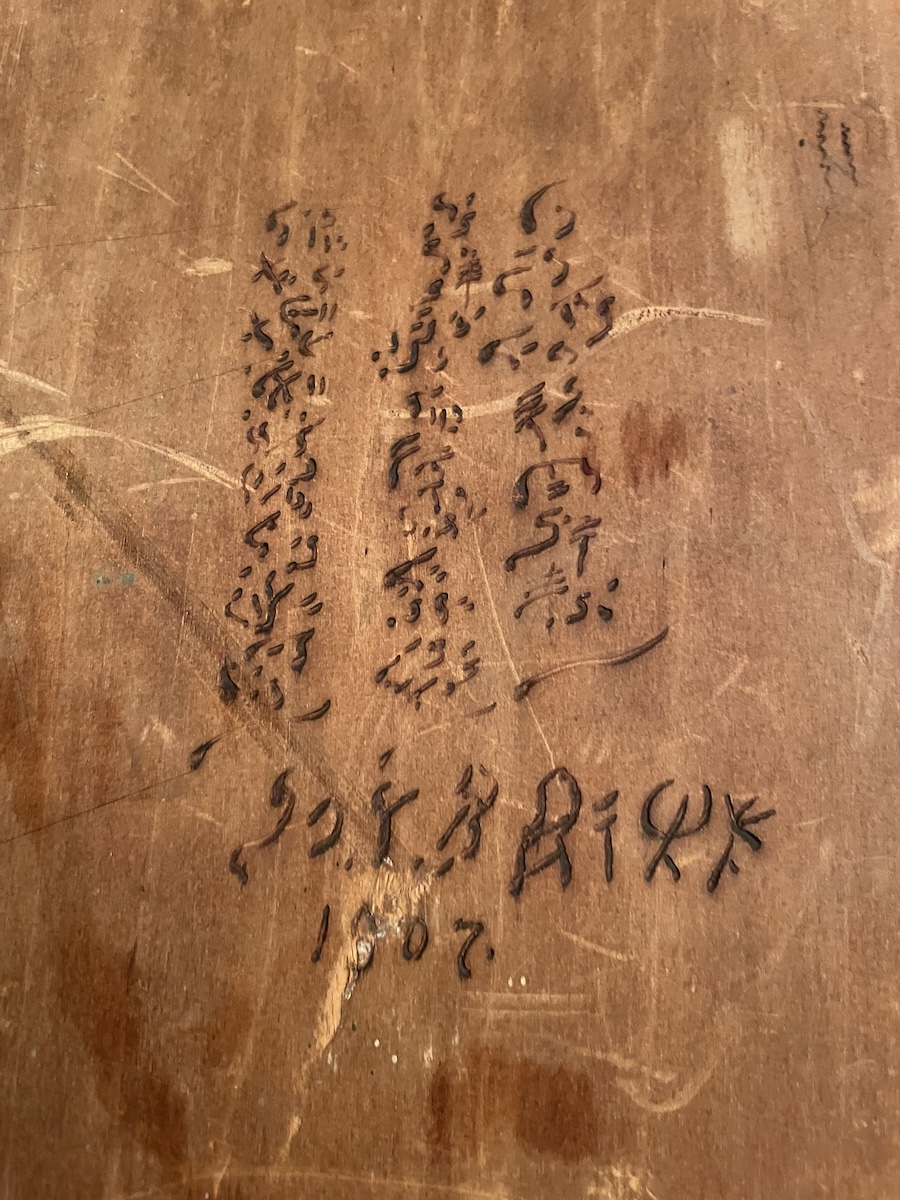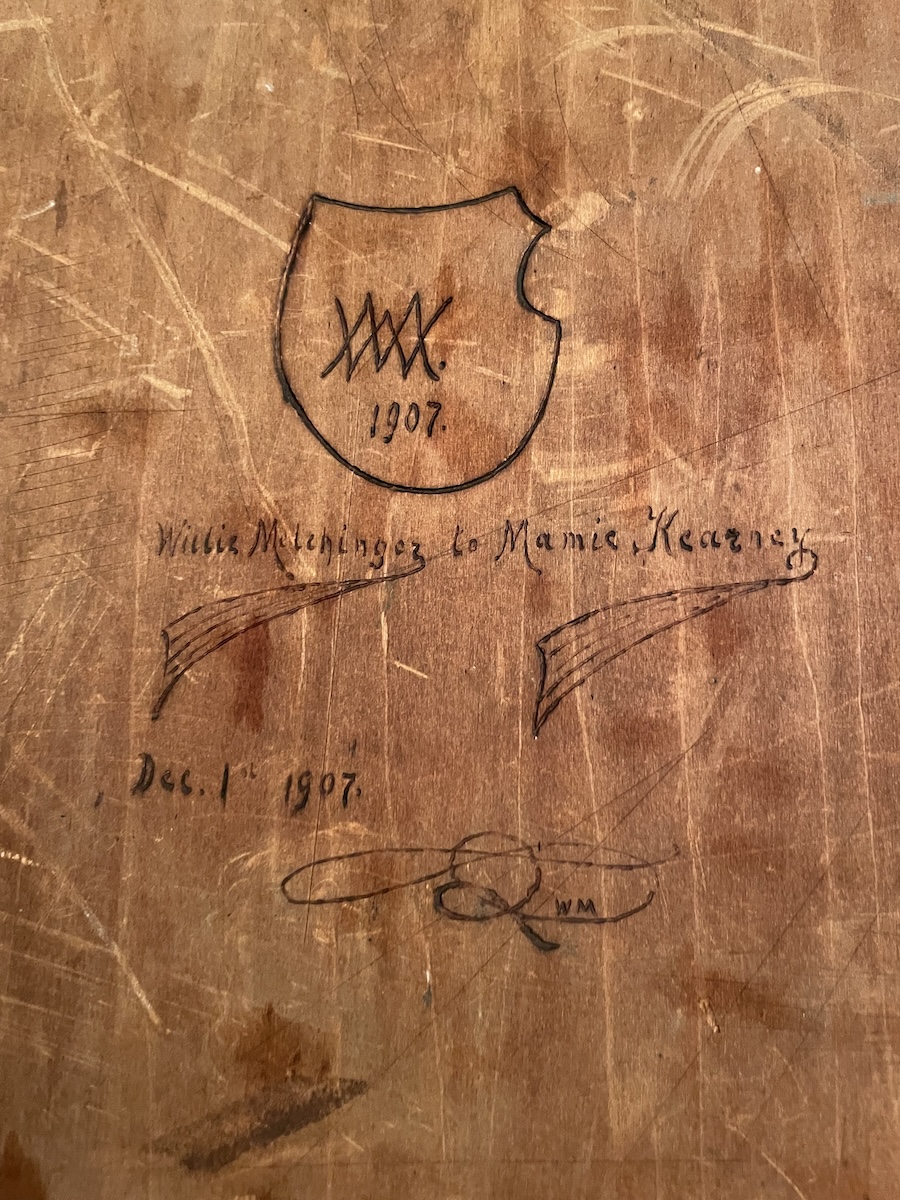Unknown language #16
« previous post | next post »
From Beverly Kahn:
Here's a puzzle that I hope you (or fellow linguists) might solve. My neighbor showed me a wood carving of what is likely an American Indian. It is dated 1907. On the back one finds markings that are like a language. Can you determine what the language is and perhaps what it says?
The (etched / burned) design-drawing on the front is exquisite. The writing on the back looks as though it was originally made with a resinous-pliable material that has dried up and partially fallen off in some places. It appears that the way the sticky (?) substance was applied made it difficult to draw tight circles.
Overall, I do not know what the language is, but I do see some symbols that look as though they could be sinoglyphs, e.g., 寿 an old simplified form of shòu 壽 ("longevity"), yáng 羊 ("ovicaprid"), a component consisting of two or three short, diagonally downward sloping strokes to the left above a perpendicular stroke, etc. Perhaps it has something to do with the birthday of the woman depicted.
Selected readings
- "Unknown language #15" (6/6/23)
- "Unknown language #14" (10/27/22)



Doctor Science said,
March 5, 2024 @ 11:05 pm
A quick look at ancestry.com leads me to a marriage certificate between William F. Melchinger and May L. Kearney, married in White Plains, NY 8 Nov. 1916.
Melchinger was born in Germany and immigrated to the US c. 1900, but I don't think this is a warped fraktur.
martin schwartz said,
March 6, 2024 @ 12:31 am
Bravo Dr. Science! In view of the feathered Ms. Kearney, it would be nice if an indigenous North American scrip were involved, but offhand
I know none suitable. Some are vaguely like Rongorongo of Easter Island. The portrait is too probably early for C.D. Batchelor,
but it reminds me of his style of cartooning actresses in the NY Daily News weekend Theater Supplements ca. 1948-1953,., cf. e.g. (e-bay)
"1950's original art–KOREAN WAR COLUMBIA CRIES C.D.Batchelor.
As for the script, I know someone who may know…I'll ask him.
Martin Schwartz
Doctor Science said,
March 6, 2024 @ 11:42 am
Now that I think about it some more, I'm betting that image is copied from an illustration of Nscho-Tschi, the heroine of Karl May's Winnetou series. It's possible that the large symbols at the bottom are based on the Cherokee syllabary, but in any event I'd ask someone in Winnetou fandom for more insight.
But I think it unlikely that they reflect any true language … though it's conceivable that they're a code, translating into an English phrase that Willie & Mamie were not yet at liberty to say in plain speech.
rpsms said,
March 6, 2024 @ 12:31 pm
Gabelsberger shorthand variant?
Not a naive speaker said,
March 6, 2024 @ 4:58 pm
First I thought of the dancing men https://en.wikipedia.org/wiki/The_Adventure_of_the_Dancing_Men
If this encrypted (some fancy symbols instead of letters) then in my option it is a monoalphabetic substitution
The prominent line above 1907 might be day and month.
1907 is written the American way: 1 is just a vertical line, the 7 has no slash.
Dan Faulkner said,
March 7, 2024 @ 3:36 pm
To my eye, these marks appear to have been incised into the wood with a heated tool (pyrography), just like the design on the front side. Perhaps this was a test area where the artist tried out strokes, verified tool temperature, etc.? It's reminiscent of the pencil doodles that I draw during boring meetings: not highly structured, but also not completely random.
Carl Masthay said,
March 11, 2024 @ 5:30 pm
I took time to check all of Daniels and Bright's The World's Writing Systems, 1996, which after May 2011 I had labored through its circa 964 pages and made a list of more than about 350 lines of errors, sent to the authors. OK, so today I checked to find a match with the unknown language script and found nothing to match it. There is a feeling that its script is vertical with one horizontal line. Above right by the 1907's 7 is a character resembling Tibeto-Burman Yi (Lolo; p. 242) gu33 'plow', but that's all. Not good enough to match. So then, there is p. 250 for the traditional hiragana arrangement to have the feel but not a match. African Vai, p. 597, has the feel but no match. No Amerindian script matches. No Indus script matches. There is a left-side S-like repetitive form on many of the unknown script characters, and each seems to be a word, not an alphabet or syllabary. These characters did not lose parts in the burnt wood. I opine that someone made a spoof for fun by burning marks on the wood in emulation of Chinese or Japanese, but we cannot know what went on in some person's mind at that time.